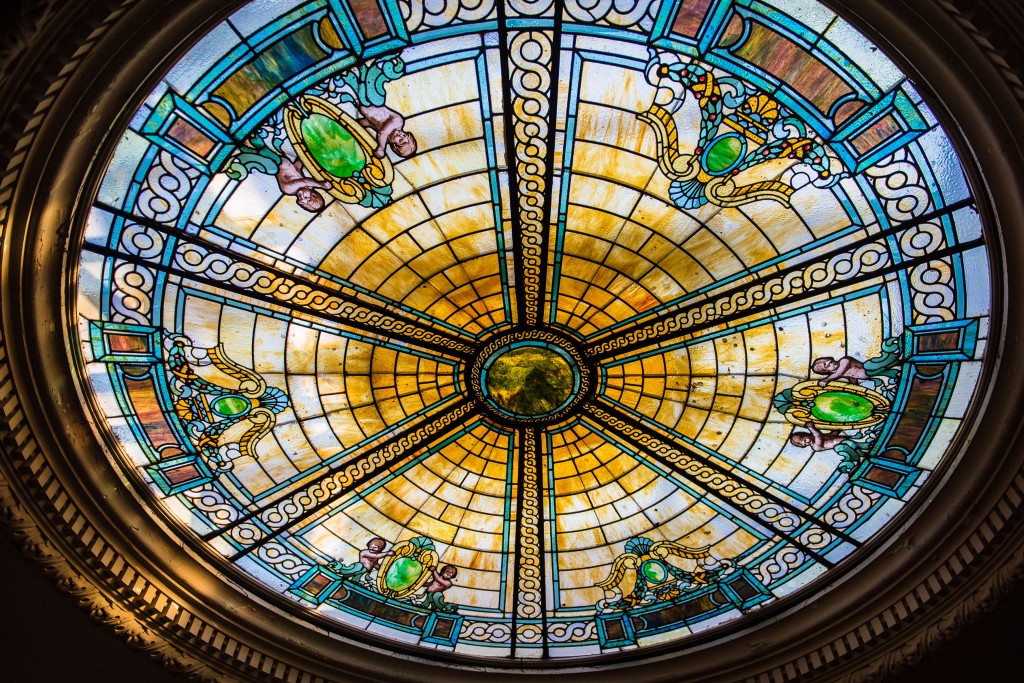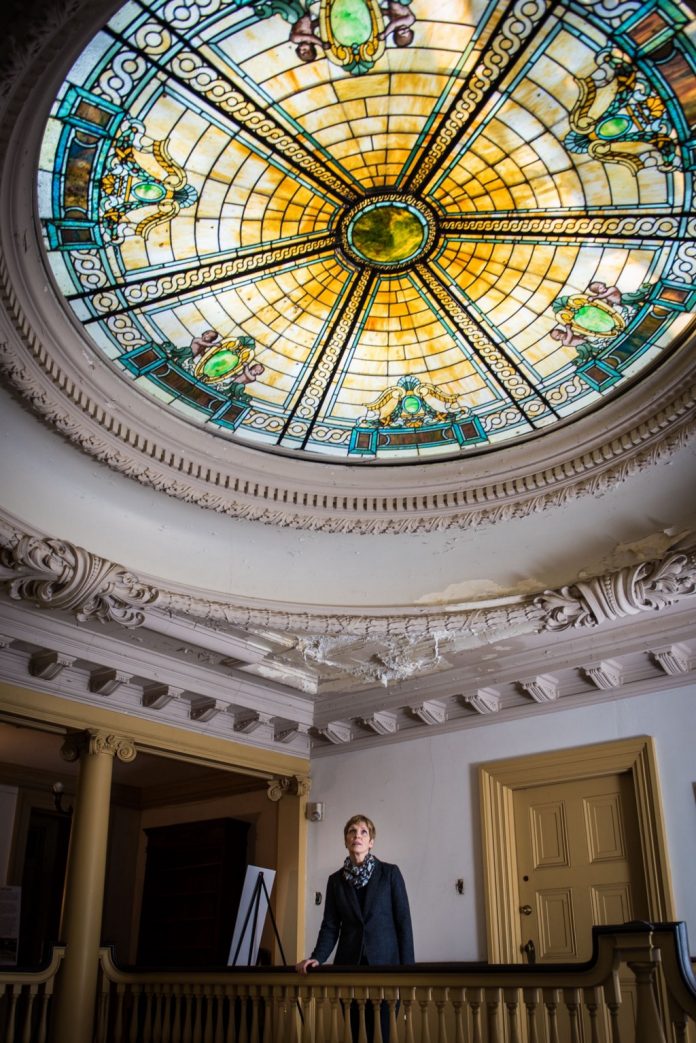Meg Sharp Walton, executive director of the nonprofit group that oversees the site, explains how the laylight is the architectural centerpiece of the interior of Glen Foerd mansion. MARIA S. YOUNG / TIMES PHOTO
Imagine waking up to the morning sun shimmering through the brilliant hues of a 15-foot stained glass window, then settling into bed each evening beneath the same decorative glow — courtesy of artificial backlighting.
Seems dreamy, doesn’t it?
That was the reality for the two daughters of Florence Foerderer Tonner, longtime mistress of the ostentatious Glen Foerd estate in Torresdale. As children in the 1920s, Marjorie and Carol each had their own bedroom on the third floor of the family mansion. Their governess and a live-in nurse occupied adjoining rooms.
A focal point of that third level was a large circular laylight, installed around the turn of the 19th century by Florence’s parents during their sweeping renovations of the mansion, which had been originally constructed a half-century earlier. The centrally configured laylight projected colorful beams from the roof, down the grand staircase and into the foyer, illuminating many of the home’s ornate architectural features and fanciful artworks.
It still does, although in somewhat muted fashion due to a perhaps inevitable deterioration that accompanies the passage of time. Yet, the Glen Foerd Conservation Corporation is about to launch a major restoration of the laylight on the heels of its imminent and lively itinerary of holiday-themed programming. The conservators will invest $40,000 in reviving the stained glass and repairing the lighting system, as well as the water-damaged plasterwork that accents the feature. The cost will be borne evenly between a Pennsylvania Historical and Museum Commission grant and the mansion’s own fundraising efforts.
“The laylight is the architectural centerpiece of the interior of the mansion, but the deterioration has really been noticeable,” said Meg Sharp Walton, executive director of the nonprofit group that oversees the city-owned site. “It’s so beautiful that people look up and then they see that the plasterwork surrounding it is really crumbling.”
At night, the laylight isn’t visible at all because the light fixtures behind it haven’t worked for ages.
“The whole purpose of the laylight is to impress,” Walton said. “Yes, the mansion is beautiful, but the crowning glory is damaged.”
Walton and the mansion’s lead curator, Erica Freeman, know that the laylight within the context of the mansion is a strong example of the extravagance typical of gilded-age America.
“They used the latest and greatest in gilded-age mansions,” Walton said.
The light features two windows, an external and an internal. The round stained glass design spans 15 feet and is seen from the inside. There is also a glass opening in the roof to allow natural light to enter. Between the windows, there is a grid of electric-powered lights to illuminate the interior window at night. White plaster mouldings surround and complement the laylight, including two concentric leafy rings and four dominant cartouches.
No one knows for sure where the laylight originated, according to Walton, but the coloring of the stained glass provides some hints. At first sight, the mansion director assumed that the seemingly darkened translucent glass was merely dirty in varying stages. But upon further research, she learned that it is actually intended to look that way. This opalescent effect is the product of a process in which few manufacturers specialized at the time.
The Opalescent Glass Works of Kokomo, Indiana, was the leading manufacturer of the day. Preeminent designers including Louis Tiffany and John LaFarge sourced materials from the company, which is now known as Kokomo Opalescent Glass and still family-owned.
“The glass likely came from Kokomo, Indiana,” Walton said of the Glen Foerd installation.
In any case, it’s quite beautiful, even in its diminished state. The circular design is divided into six wedges that give the illusion of three dimensions, as if the viewer is standing beneath a dome. The panels feature cherubs and shields in a palette of ambers, browns, greens and blues. The composition is so captivating that the conservation corporation features it on all of its printed communications like newsletters, business cards and news releases.
“It’s very colorful. The geometry of the design is very pleasing. It fits with the rest of the mansion. It’s gorgeous,” Walton said.
The restoration work is scheduled to start in January and should last three months. In anticipation of the project, visitors to the mansion will be granted access to the third floor for the first time ever via the servants’ stairs to view the laylight from close range. The mansion has set up informational panels discussing the history of the light.
As the project moves forward, Glen Foerd will post updates and photos on its website. Eventually, families from the community will be invited to a celebration of the project’s completion featuring additional tours and arts and crafts for kids.
According to Walton, the stained glass theme transcends the mansion’s traditional Christmas decor this year. The tree was decorated in jewel-toned color blocks by two volunteers from Feeney’s garden center in Feasterville.
“It’s like you would see on a stained glass window,” Walton said. “Everyone gets their pictures taken here.”
The mansion will host a public Christmas at the Mansion party on Saturday, Dec. 5, from 1 to 6 p.m. featuring children’s crafts, caroling, live music and ballet performances. Students from Settlement Music School’s Kardon Northeast Branch will be featured, as will the bell choir of Nazareth Academy.
On the following Saturday, Dec. 12, the White Pines Productions theater group will present The Holiday Affair: A Roaring 20s Melodrama. As a continuation of Glen Foerd’s successful Roaring 20s Lawn Party last summer, guests are invited to dress in period clothing while taking in an interactive melodrama that will play out in the various rooms of the mansion. Performances will run every half hour from 7 to 10 p.m. A “speakeasy” with cash bar and music by The Gin Canaries will fill the rathskeller throughout the evening.
For more information about these and other upcoming Glen Foerd events, visit the “programs and events” page at www.glenfoerd.org. ••

Preserving history: The Glen Foerd Conservation Corporation is planning a major restoration of a large circular laylight, installed around the turn of the 19th century. The conservators will invest $40,000 in reviving the stained glass. MARIA S. YOUNG / TIMES PHOTO





